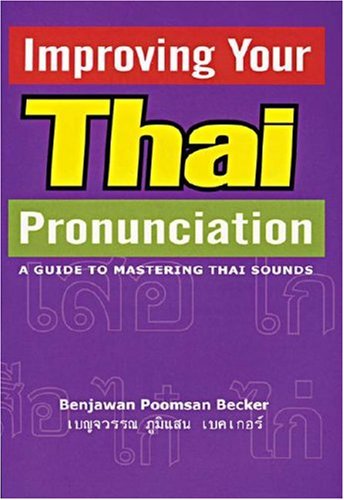Thai is a tonal language; if you say something with the wrong tone it can have an entirely different meaning. For a non-native Thai speaker, the five tones can be quite confusing; the word “maa” can mean “come”, “horse” or “dog” depending on the tone. “Khao” can mean “enter”, “white”, “rice”, “Mountain”, “he/she” or “news”. See how confusing this can be? That’s why it’s extra important to allot a good portion of your study time to perfecting your listening and pronunciation skills. If you don’t have a Thai teacher, this can be tricky. But don’t worry; thanks to Improving your Thai Pronunciation: A Guide to Mastering Thai Sound, it’s not impossible.
The book and audio series helps foreigners to master the art of identifying and pronouncing the various tones of the Thai language. The written book is accompanied by an audio CD, which is a crucial part of the learning experience; without the audio you will probably be unable to pronounce things correctly.
"Basically, the book is just pages and pages of lists. Along with the CD, this lesson book is intended to familiarize your ear with the sounds of the Thai language, which are quite different from other western languages."
At just 45 pages, the book is rather short; the main goal is to outline similar sounds, short and long vowels, different tones/meanings, and so on. Basically, the book is just pages and pages of lists. Along with the CD, this lesson book is intended to familiarize your ear with the sounds of the Thai language, which are quite different from other western languages. At the beginning of the book, it explains the phonetic system used in Romanized Thai so that you can properly read the tones and vowels as you go along. It’s always a great idea to listen to the CD as well so that you can totally familiarize yourself with the patterns of speech.
By the end of the book and audio lesson, you should be able to distinguish between mid, low, falling, high and rising tones in Thai. If you spend ample time studying the book and listening to the CD, you should be able to tell the difference between “paa”-“to take” and “paa”- “to spit”; you’ll know that first one is a mid tone and the latter a low tone.

The best part about this book is that it comes in handy for students of all levels. Even if you have studied Thai for years, it’s a good idea to review your pronunciation and understanding of the Thai tonal system. The only complaint is that the book and CD are rather short. The book could have easily been extended and given more pronunciation practice to help students truly get a handle on Thai pronunciation. A dedicated student can whiz through this book in a matter of 1-2 weeks. While he/she can always review it and still learn something, it would have been better to have more content from the beginning.



